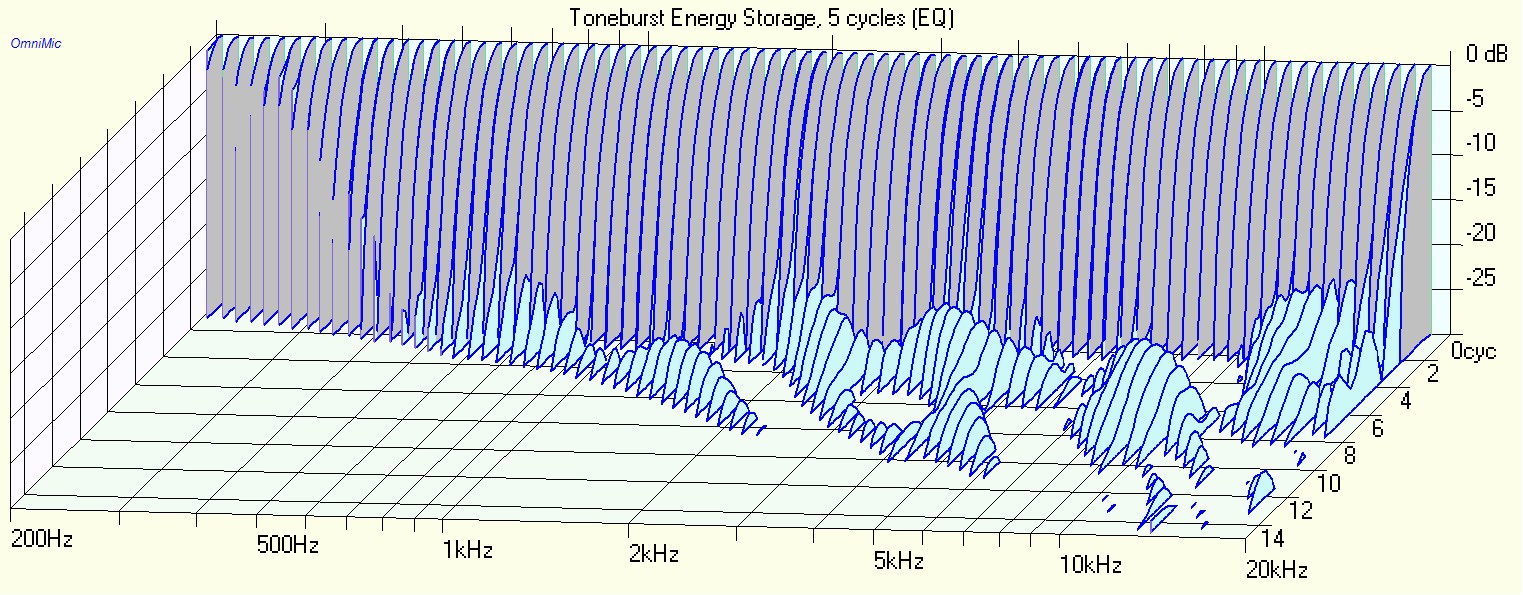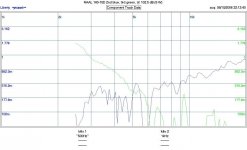In the SNR-1 I use the Mundorf AMT25CM1.1-R tweeter along with the famous ScanSpeak 7", 4 Ohm Revelator woofer. I used OmniMic and my Logitech Squeezebox to make this as easy on myself as possible, as a result, absolute levels at 1kHz could be off by a db or so.
The speakers use a target crossover of around 2.8kHz.
Measurements were taken from 3' away in my living room using the blended settings, so it's likely that only measurements above 1kHz are time gated.
First, the compression measurement. I compare 70 db vs. 95 db frequency response.
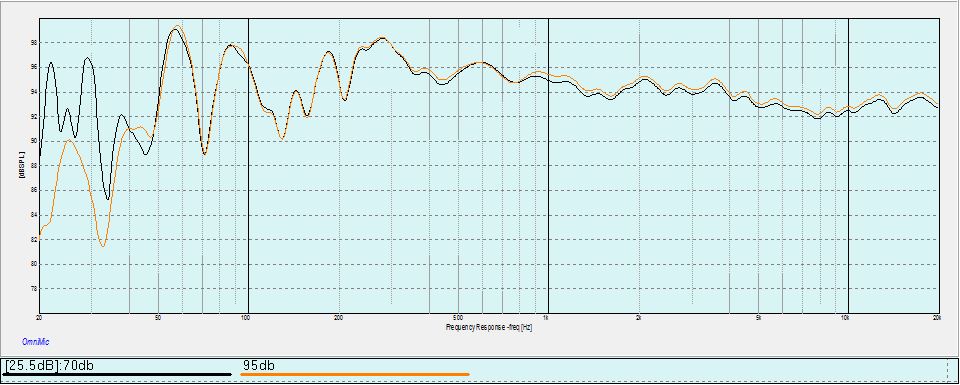
Distortion measurements are really good, though the woofer shows some 2nd order distortion starting around 80 db.
Here we have it at 70 db:
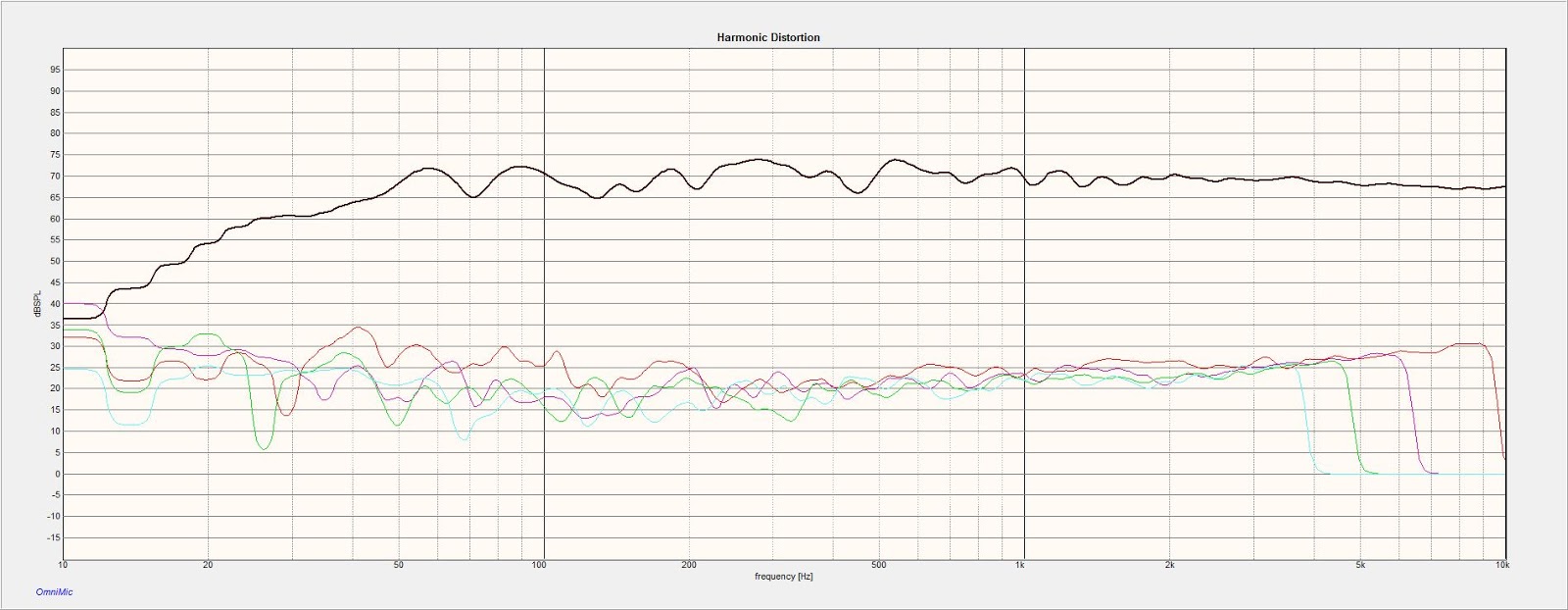
By 80 db we see the 2nd harmonic show up in the woofer, but it's kind of boring, so I'll post 85 and 95 db instead:
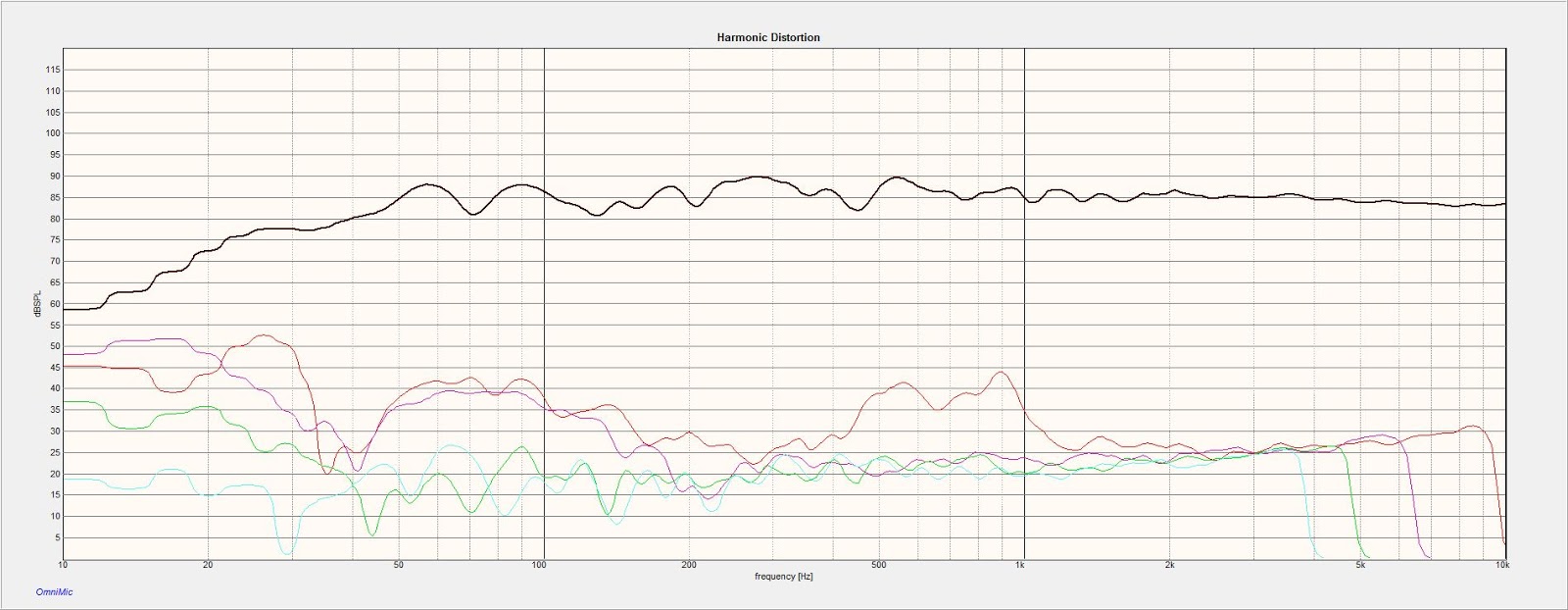
95 db distortion. Now the tweeter starts to show some 2nd order harmonic distortion:
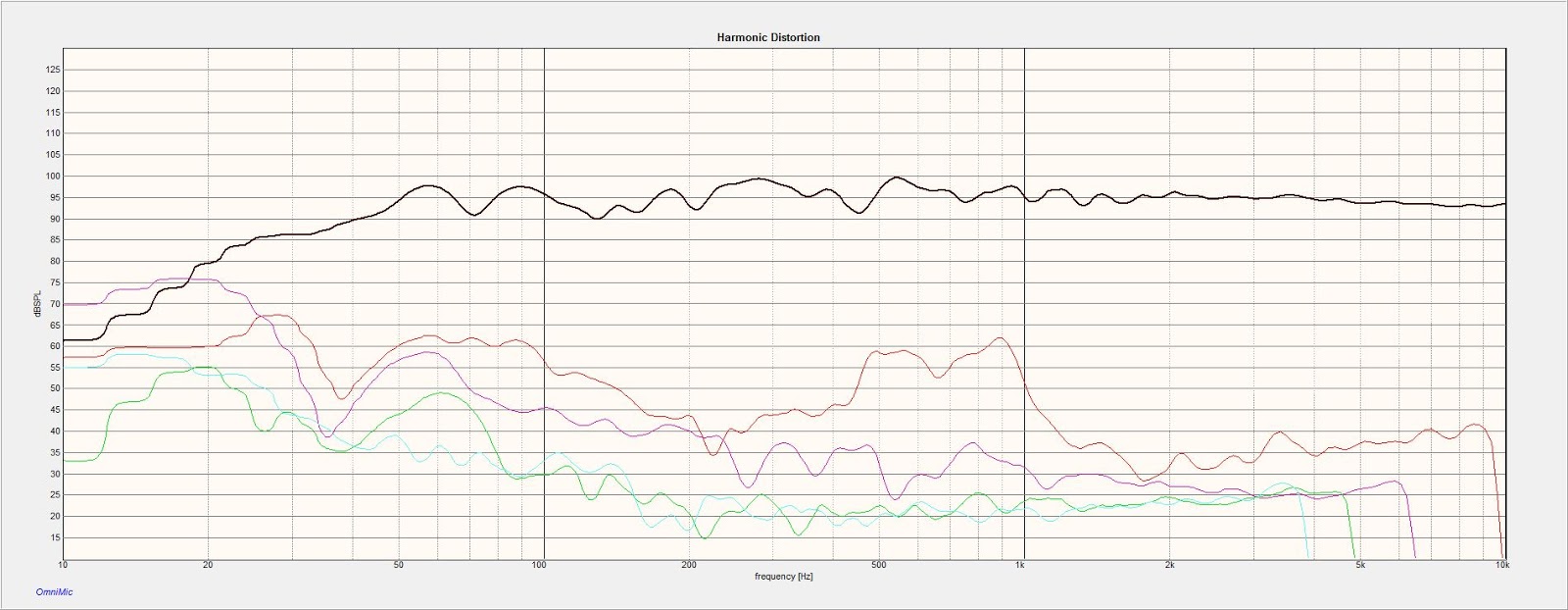
The speakers use a target crossover of around 2.8kHz.
Measurements were taken from 3' away in my living room using the blended settings, so it's likely that only measurements above 1kHz are time gated.
First, the compression measurement. I compare 70 db vs. 95 db frequency response.

Distortion measurements are really good, though the woofer shows some 2nd order distortion starting around 80 db.
Here we have it at 70 db:

By 80 db we see the 2nd harmonic show up in the woofer, but it's kind of boring, so I'll post 85 and 95 db instead:

95 db distortion. Now the tweeter starts to show some 2nd order harmonic distortion:

Last edited:
Looks like you have significant diffraction in that speaker (from the ridges moving to the right). Otherwise quite clean.
dave
Thanks Dave! I was wondering what that was. I'm afraid these charts are a little new to me. Probably has something to do with the end table they are sitting on. LOL!

Something is wrong. The measurement is somehow flawed.
It is not possible to get decreasing distortion with increasing SPL, like-45dB dist. at 70dB and -60dB at 95dB.
I'd start by measuring closer, removing as much room reverb as possible...
The minimum distance depends on the mike dist rating vs. max SPL that you want to do the dist. measurement.
It would be good if you could use cosine envelope on bursts, too. That prevents displacement of zero level in amps, as well as diaphragm displacement from leading edge of the burst and letting the settlement time to change the burst shape that you are picking up.
That will also allow you to do high SPL measurements, where the initial "pop" (when the burst turns on) won't kill your amp and/or wrinkle the voice coil former...
It is not possible to get decreasing distortion with increasing SPL, like-45dB dist. at 70dB and -60dB at 95dB.
I'd start by measuring closer, removing as much room reverb as possible...
The minimum distance depends on the mike dist rating vs. max SPL that you want to do the dist. measurement.
It would be good if you could use cosine envelope on bursts, too. That prevents displacement of zero level in amps, as well as diaphragm displacement from leading edge of the burst and letting the settlement time to change the burst shape that you are picking up.
That will also allow you to do high SPL measurements, where the initial "pop" (when the burst turns on) won't kill your amp and/or wrinkle the voice coil former...
Something is wrong. The measurement is somehow flawed.
It is not possible to get decreasing distortion with increasing SPL, like-45dB dist. at 70dB and -60dB at 95dB.
Why not? This is how we measure amplifiers.
I suspect we are seeing the limitations of my inexpensive software and measurement tools. I suspect that at the very least, there is a minimum level before distortion can be measured at all.
I'd start by measuring closer, removing as much room reverb as possible...
The minimum distance depends on the mike dist rating vs. max SPL that you want to do the dist. measurement.
It would be good if you could use cosine envelope on bursts, too. That prevents displacement of zero level in amps, as well as diaphragm displacement from leading edge of the burst and letting the settlement time to change the burst shape that you are picking up.
That will also allow you to do high SPL measurements, where the initial "pop" (when the burst turns on) won't kill your amp and/or wrinkle the voice coil former...
I only wish I had that kind of capabilities. I'm afraid using OmniMic I have no such test signals available to me. I could take closer measurements, but given the software I don't think you'll see it behave much better. Maybe Bill Waslo, the creator of OmniMic and XSim will chime in here and help us.
Best,
Erik
I don't get that CSD plot.
Is that with speaker response normalized to 0 level?
I prefer the plots where I can see the speaker's response on top, so at least I'm sure I'm not measuring the probe that is attached to the amp output...
I really hate guys with sophisticated tools and their sophisticated software which I don't have. I get such incredible tool envy.
Using OmniMic, I have no signal generator. I use test tracks ripped to my server. The time/energy plot was flattened so all frequencies start at 0. Sorry! I guess for you I should have left it alone.
Best,
Erik
So true!
No, I mean, the trends are there to be seen and that's fine, but the right magnitude will speak volumes.
As for the level, if you dare taking it to 100-105dB, that'll be something!
In general, everything looks really good and that Mundorf is a great tweeter, indeed! I really like it, too!
Well, I'm a very happy user of Bill's Praxis for 10 years now!
I'm not sure right now if free version will do the burst envelope, but it might. I'll check that out tomorrow and let you know.
I really hate guys with sophisticated tools and their sophisticated software which I don't have. I get such incredible tool envy.Amp output.... yeah, in my dreams here.

Using OmniMic, I have no signal generator. I use test tracks ripped to my server. The time/energy plot was flattened so all frequencies start at 0. Sorry! I guess for you I should have left it alone.
Best,
Erik
Hmmm, I think I can save the cosine envelope burst as WAV files...
I'm not promising anything, though, but if I do get to do that, I'll send you the files.
EDIT: yes, I like to look at how wiggles in response develop into ridges on CSD, for finding the breakups and their origin. Some wiggles originate from mechanical resonances, some from acoustical environment in the vicinity of diaphragm, some are benign, some not...
Last edited:
OK, I have gone back and measured the distortion figures for the 95 and 100 db mark.
Sadly I can't save these, so I have to measure each time I want to look at something.
For this chart:

First, the distortion lines appear logarithmic. For the 850Hz peak the total distortion (2nd through 5th Harmonic) is around 1.06%. Of course we attribute this to the woofer. At 2kHz total distortion is around 0.09%, rising to a peak of around 0.16% at 3.3kHz and 7kHz.
At 100 db (the loudest I dare in my apartment) minor increases in the total distortion occurs but the profile remains the same shape. At 850Hz it's around 2%, while the tweeter peaks have gone up to 0.18% and 0.24 % for 3.3kHz and 7kHz respectively.
Damn fine figures.
Erik
Sadly I can't save these, so I have to measure each time I want to look at something.
For this chart:

First, the distortion lines appear logarithmic. For the 850Hz peak the total distortion (2nd through 5th Harmonic) is around 1.06%. Of course we attribute this to the woofer. At 2kHz total distortion is around 0.09%, rising to a peak of around 0.16% at 3.3kHz and 7kHz.
At 100 db (the loudest I dare in my apartment) minor increases in the total distortion occurs but the profile remains the same shape. At 850Hz it's around 2%, while the tweeter peaks have gone up to 0.18% and 0.24 % for 3.3kHz and 7kHz respectively.
Damn fine figures.
Erik
Last edited:
Damn fine, indeed!
That huge diaphragm area must count for something! Excellent! Clean and neutral!
I wonder if I can ask you to do the dist. measurement of the tweeter alone, no crossover, no SS, starting from 2-2.5k?
And if it could possibly be at 102.5dB, that would be awesome, as I have my measurements done at that level, so I'd like to compare.
As for the SS between 500Hz and 1k, it shouldn't be that high.
Please try to put the speaker on a stand of different height and on a different place in the room and put the mike 1.5 feet away...it could be that reflections are doing something to that region, since it's not strictly gated.
Also, put a blanket or a pillow between the stool and speaker, just in case there's some structural vibrations getting reinforced...
Cheers!
That huge diaphragm area must count for something! Excellent! Clean and neutral!
I wonder if I can ask you to do the dist. measurement of the tweeter alone, no crossover, no SS, starting from 2-2.5k?
And if it could possibly be at 102.5dB, that would be awesome, as I have my measurements done at that level, so I'd like to compare.
As for the SS between 500Hz and 1k, it shouldn't be that high.
Please try to put the speaker on a stand of different height and on a different place in the room and put the mike 1.5 feet away...it could be that reflections are doing something to that region, since it's not strictly gated.
Also, put a blanket or a pillow between the stool and speaker, just in case there's some structural vibrations getting reinforced...
Cheers!
Damn fine, indeed!
That huge diaphragm area must count for something! Excellent! Clean and neutral!
I wonder if I can ask you to do the dist. measurement of the tweeter alone, no crossover, no SS, starting from 2-2.5k?
And if it could possibly be at 102.5dB, that would be awesome, as I have my measurements done at that level, so I'd like to compare.
I'll show you mine if you show me yours.
Erik
Here it is.
It is an old measurement, before the elastic suspension from a year ago, as during the development I didn't have those measurements properly for publishing, so for the record, this oldie is not relevant any more.
Anyhow, when the crossover is applied and when the midrange driver contributes to the output in the crossover region, the distortion up to 5k is dramatically lowered compared to the tweeter alone without the crossover.
In case of a speaker with 140-15D (in box, crossed at 2k5 with midrange working), measured at this level (102-103dB), it can be as low as .4 % between 2k and 5k.
With spectral distribution of musical signal, that means that the SPL at 500Hz is about 6-12 dB higher, which is about the maximum output of such speaker.
All in all, one must be very careful when interpreting the raw tweeter distortion and keep two things in mind:
1) In finished speaker, the crossover region with midrange will show much smaller distortion.
2) In finished speaker, the actual SPL of the tweeter will average to 6-12dB lower than the SPL coming from the midrange driver, due to music signal spectrum (measure the average and instantenous voltage on mid and tweeter while your preferred genre of music is playing and compare those numbers to find the relevance of your distortion measurements)
I am interested to see how the distortion rises (if at all) in that AMT as you go down and compare that to the result in the box.
It is an old measurement, before the elastic suspension from a year ago, as during the development I didn't have those measurements properly for publishing, so for the record, this oldie is not relevant any more.
Anyhow, when the crossover is applied and when the midrange driver contributes to the output in the crossover region, the distortion up to 5k is dramatically lowered compared to the tweeter alone without the crossover.
In case of a speaker with 140-15D (in box, crossed at 2k5 with midrange working), measured at this level (102-103dB), it can be as low as .4 % between 2k and 5k.
With spectral distribution of musical signal, that means that the SPL at 500Hz is about 6-12 dB higher, which is about the maximum output of such speaker.
All in all, one must be very careful when interpreting the raw tweeter distortion and keep two things in mind:
1) In finished speaker, the crossover region with midrange will show much smaller distortion.
2) In finished speaker, the actual SPL of the tweeter will average to 6-12dB lower than the SPL coming from the midrange driver, due to music signal spectrum (measure the average and instantenous voltage on mid and tweeter while your preferred genre of music is playing and compare those numbers to find the relevance of your distortion measurements)
I am interested to see how the distortion rises (if at all) in that AMT as you go down and compare that to the result in the box.
Attachments
Try using REW software. It has all these features plus signal generator. It's free too.
I don't even look back at my other software now.
The speaker should be about 1/2 way between floor and ceiling. Gating the meas. to about 2-3 msec will remove room reflections as long as the speaker is reasonably away from any walls.
I usually point my DUT's in a diagonal direction in my squarish room.
- Status
- This old topic is closed. If you want to reopen this topic, contact a moderator using the "Report Post" button.
- Home
- Loudspeakers
- Multi-Way
- Mundorf AMT + SS 7 Compression and Distortion
